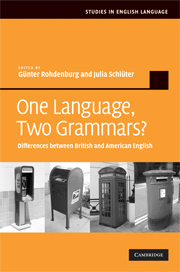Book contents
- Frontmatter
- Contents
- List of figures
- List of tables
- List of contributors
- Introduction
- 1 Colonial lag, colonial innovation or simply language change?
- 2 Compound verbs
- 3 The formation of the preterite and the past participle
- 4 Synthetic and analytic comparatives
- 5 Phonology and grammar
- 6 Prepositions and postpositions
- 7 Argument structure
- 8 Reflexive structures
- 9 Noun phrase modification
- 10 Nominal complements
- 11 Non-finite complements
- 12 The present perfect and the preterite
- 13 The revived subjunctive
- 14 The mandative subjunctive
- 15 The conditional subjunctive
- 16 Tag questions
- 17 The pragmatics of adverbs
- 18 How different are American and British English grammar? And how are they different?
- 19 New departures
- Bibliography
- Index
Introduction
Published online by Cambridge University Press: 03 July 2009
- Frontmatter
- Contents
- List of figures
- List of tables
- List of contributors
- Introduction
- 1 Colonial lag, colonial innovation or simply language change?
- 2 Compound verbs
- 3 The formation of the preterite and the past participle
- 4 Synthetic and analytic comparatives
- 5 Phonology and grammar
- 6 Prepositions and postpositions
- 7 Argument structure
- 8 Reflexive structures
- 9 Noun phrase modification
- 10 Nominal complements
- 11 Non-finite complements
- 12 The present perfect and the preterite
- 13 The revived subjunctive
- 14 The mandative subjunctive
- 15 The conditional subjunctive
- 16 Tag questions
- 17 The pragmatics of adverbs
- 18 How different are American and British English grammar? And how are they different?
- 19 New departures
- Bibliography
- Index
Summary
Differences between British and American English: One language, two grammars?
In 1789, not long after the American Declaration of Independence, Noah Webster still had reason to believe that British and American English (BrE and AmE) would in the long run drift apart, just like other Germanic dialects that have evolved into the modern languages Dutch, Danish, Swedish, German, etc.: ‘several circumstances render a future separation of the American tongue from the English, necessary and unavoidable’ (Webster 1789: 22). More than 200 years later, these expectations have not been confirmed, and there are at present no signs that this will happen even in the distant future. In their discussion of the question ‘Two languages or one?’, Marckwardt and Quirk (1964: 9–13) thus conclude that what we refer to as BrE and AmE should still be considered as one and the same language.
However, at many levels of description, British–American contrasts are widely recognized. Thus, in the phonological domain, the British Received Pronunciation and General American differ markedly. Lexical oppositions are notorious and provide the material for numerous cross-varietal vocabulary lists and dictionaries. At the pragmatic level, British and American habits are (at least impressionistically) known to vary to a considerable extent. In stark contrast, with regard to the title question of the present volume, most linguists would probably be inclined to reply that British and American of course share the same grammar (for a recent statement to this effect, see Mair 2007a: 98).
- Type
- Chapter
- Information
- One Language, Two Grammars?Differences between British and American English, pp. 1 - 12Publisher: Cambridge University PressPrint publication year: 2009
- 3
- Cited by



